Kėdainiai
Kėdainiai (Lithuanian: [kʲeːˈdâːɪnʲɛ] (![]()
Kėdainiai | |
|---|---|
City | |
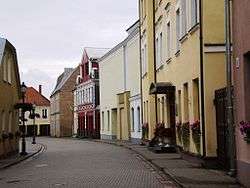 Kėdainiai old town | |
.svg.png) Coat of arms | |
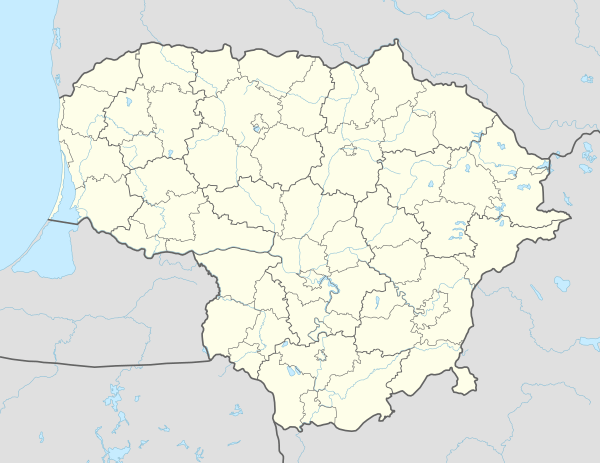 Kėdainiai Location of Kėdainiai | |
| Coordinates: 55°17′N 23°58′E | |
| Country | |
| Ethnographic region | Aukštaitija |
| County | |
| Municipality | Kėdainiai district municipality |
| Eldership | Kėdainiai town eldership |
| Capital of | Kėdainiai district municipality Kėdainiai town eldership |
| First mentioned | 1372 |
| Granted city rights | 1590 |
| Neighbourhoods | List
|
| Government | |
| • Type | Municipal Council |
| • Mayor | Valentinas Tamulis[1] |
| Area | |
| • Total | 27.0 km2 (10.4 sq mi) |
| Elevation | 39 m (128 ft) |
| Population (2020) | |
| • Total | 22,677 |
| • Density | 840/km2 (2,200/sq mi) |
| Time zone | UTC+2 (EET) |
| • Summer (DST) | UTC+3 (EEST) |
| Postal code | 57xxx |
| Website | www |
The city is the administrative centre of the Kėdainiai District Municipality. The geographical centre of the Lithuanian Republic is in the nearby village of Ruoščiai, located in the eldership of Dotnuva.
Names
The city has been known by other names: Kiejdany in Polish, Keidan (קיידאן) in Yiddish,[3] and Kedahnen in German. Kėdainiai other alternate forms include Kidan, Kaidan, Keidany, Keydan, Kiedamjzeÿ [4] ("j" /e/), Kuidany, and Kidainiai.[5]
History

The area was the site of several battles during "The Deluge", the 17th century war between the Polish-Lithuanian Commonwealth and Sweden. In 1655 a short-lived treaty with Sweden, the Union of Kėdainiai, was signed by two members of Radziwiłł family in their Kėdainiai castle. While little remains of the Radziwiłł castle, the crypt of the Calvinist church (1631) houses the family mausoleum, including the tombs of Krzysztof Radziwiłł and his son Janusz.
Scottish Protestants arrived in the late 16th and 17th centuries, encouraged by the conversion of Anna Radziwill; the community exerted considerable influence in the city and persisted until the mid-19th century.[6]
A local custom called on all visitors to bring a stone to be used in the town's construction.[2]
World War II
During Operation Barbarossa, Kėdainiai was occupied by the German Army in the summer of 1941. On August 28, 1941, the entire Jewish community of Kėdainiai, a community which had been there for 500 years, were killed under the direction of German Special Police Battalions, with the aid of the local Lithuanian population. The Jewish population prior to the Holocaust was 3000.[7]
Soviet period
During the Cold War it was home to Kėdainiai air base, a major Soviet military airlift facility.
For many years, Kėdainiai was known for its chemical and food processing industries. The Kėdainiai chemical plant, Lifosa began operations in January 1963. Publicized as a milestone in the industrialization of Lithuania, it emitted significant quantities of sulfuric acid and was the subject of ecological protests in the 1980s.[8][9]
Independent Lithuania
Following years of stagnation, old enterprises have come back to life, and new ones have been established, contributing to its status as an economic stronghold.[10]
Transportation
Kėdainiai is accessed by Via Baltica highway from Kaunas and Panevėžys, and by rail from Vilnius, Klaipėda and Šiauliai. It is also served by Kaunas International Airport, the second largest airport in Lithuania, located in Karmėlava site.
Cultural activities
The Kėdainiai Regional Museum, established in 1922, now operates four branches: a Multicultural Centre, the Mausoleum of the Dukes Radziwill, the House of Juozas Paukštelis, and the Museum of Wooden Sculptures of V.Ulevičius.[11]
Since the city is known as the cucumber capital of Lithuania, it sponsors an annual cucumber festival.[10]
In 2013, the band Bastille shot a music video for their single "Things We Lost in the Fire" in the location.
A small Polish minority of 329 (0,61%)[12] people live in Kėdainiai district municipality, but only 30 people participate in Stowarzyszenie Polaków Kiejdan (The Kėdainiai Polish Association), the elder people; their cultural activities involve public celebrations of Polish Day of Independence and Day of the Constitution of Third of May, as well as organizing a festival of Polish culture. Since 1994 a School of Polish Language exists.[13][14]
Education
- Jonušas Radvila College (Kėdainių Jonušo Radvilos studijų centras)
- Kėdainiai Atžalynas gymnasium
Sport
Basketball club BC Nevėžis, which parcicipate in Lithuanian basketball league. Football club FK Nevėžis, named after the nearby river plays in second-tier league I Lyga. Other football teams include FK Lifosa and FK Nevėžis-2, the reserve team of Nevėžis.
Mayors of Kėdainiai
| Portrait | Mayor | Term of Office | Political Party | |
|---|---|---|---|---|
| Took Office | Left Office | |||
| Independent Lithuania | ||||
| Petras Baguška | 1990 | 1994 | ||
| Vigimantas Kisielius | 1995 | 1997 | Homeland Union | |
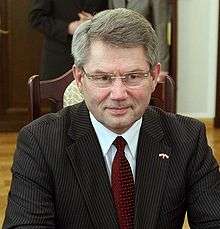 |
Viktoras Muntianas | 1997 | 2004 | Labour Party |
| Virginija Baltraitienė | 12 November 2004 | 12 December 2005 | Labour Party | |
| Nijolė Naujokienė | 2005 | 2011 | Labour Party | |
| Rimantas Diliūnas | 2011 | 2015 | Labour Party | |
| Saulius Grinkevičius | 17 April 2015 | 2019 | Liberal Movement | |
| Valentinas Tamulis | 17 March 2019 | Incumbent | Valentino Tamulio komanda – mūsų krašto sėkmei | |
Notable citizens
- Antanas Mackevičius, a priest and a leader of the 1863 uprising
- Czesław Miłosz, Polish writer, Nobel Prize winner. Born in Šeteniai village
- Mikalojus Daukša, Lithuanian writer, translator
- Martin (Moshe) Kagan, a leader of the anti-Nazi resistance group HaShomer HaTzair
- Ezekiel Katzenellenbogen, rabbi and prolific author
- Avrohom Eliyahu Kaplan (1890-1924), prominent Orthodox rabbi.
- Moshe Leib Lilienblum, Jewish scholar and author
- Viktoras Muntianas, Lithuanian politician, former Speaker of the Seimas
- Juozas Paukštelis, author
- Juozas Urbšys, Lithuanian diplomat. Born in Šeteniai village
- Shlomo Zalman Zoref, re-established the Ashkenazi community in the Old City of Jerusalem in 1811
Twin towns — sister cities
Kėdainiai is twinned with:[15]
Image gallery
 St. Joseph's church of Carmelites
St. Joseph's church of Carmelites St. George's church, 15th century
St. George's church, 15th century City Hall and Monument of Radziwiłł
City Hall and Monument of Radziwiłł Kranto II street in the old town
Kranto II street in the old town Evangelical church
Evangelical church- Senoji street in old town
- Kėdainiai market square
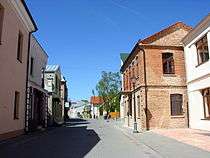 Kėdainiai old town
Kėdainiai old town Didžioji street
Didžioji street- Nevėžis river in city center
- Kėdainiai new synagogue
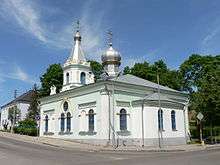
See also
References
- History of Kėdainiai

- www.kedainiai.lt
- www.visitkedainiai.lt - Kėdainiai tourism information center
- Article on Kedainiai's Jewish community
- JRK Center College of Janusz Radziwiłł
- Notes
- "Būsimieji merai švenčia, apie darbus galvos rytoj" (in Lithuanian). 15min.lt. 18 March 2019. Retrieved 24 March 2019.
- "Kėdainiai". Samogitian Cultural Association Editorial Board. Retrieved 2009-07-03.
- Levin, Dov (2000). The Litvaks. Berg Publishers. p. 48. ISBN 978-1-57181-264-3.
- Blaeu, Joan (1662). LIVONIA vulgo Lyefland (Map).
- Library of Congress Authority control Name Headings. HEADING: Kėdainiai (Lithuania). Accessed 2009-09-14.
- Murdoch, Steve (2006). Network North: Scottish kin, commercial and covert association in Northern Europe, 1603-1746. BRILL. ISBN 978-90-04-14664-8.
- Gilbert, Martin (2004). The Second World War: A Complete History. Macmillan Publishers. p. 214. ISBN 978-0-8050-7623-3.
- Casper, Monica J. (2003). Synthetic planet: chemical politics and the hazards of modern life. Routledge. ISBN 978-0-415-93355-1.
- A. P. J. Mol, David Allan Sonnenfeld (2000). Ecological Modernisation Around the World: Perspectives and Critical Debates. Routledge. ISBN 978-0-7146-5064-7.
- "Kėdainiai district municipality". Department of Statistics to the Government of the Republic of Lithuania. Retrieved 2009-06-11.
- "Museum History". Kėdainiai Regional Museum. Retrieved 2009-06-11.
- Number of inhabitants of Kėdainiai district municipality by ethnicity, "Archived copy". Archived from the original on 2013-10-02. Retrieved 2014-01-02.CS1 maint: archived copy as title (link) Lithuanian census of 2011
- Świat Polonii, Dni Kultury Polskiej na Laudzie 18-20 czerwca 2004 r.
- http://www.knypava.lt Archived 2014-01-02 at the Wayback Machine Kėdainiuose giliai šaknis įleidę ir lenkai
- "Tarptautinis bendradarbiavimas". kedainiai.lt (in Lithuanian). Kėdainiai. Retrieved 2019-08-29.
| Wikimedia Commons has media related to Kėdainiai. |
